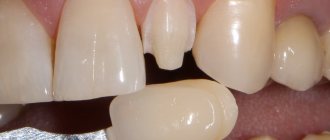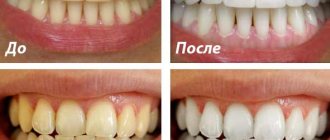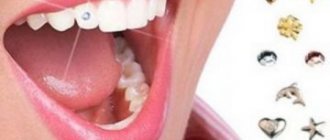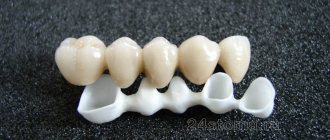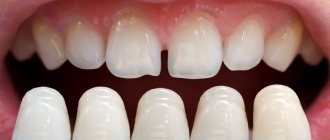In what cases are veneers placed, and who can do it?
Microprosthetic surgery is suitable for people over 18-20 – those whose teeth are already fully formed.
Accordingly, it is better for children and adolescents to wait. To undergo the procedure, a person must be healthy. Caries and other oral diseases must first be cured.
A suitable surface for fixing the pads is also important. If the incisor has been torn out, an implant is first placed in its place and a plate is fixed on it.
Situation: veneer failed
In practice, there were cases when the veneer fell off. How to fix? You need to assess the situation and carefully study the problem, and the doctor will suggest a solution.
If the material has simply peeled off, then you need to remove it with careful movements (so as not to damage it).
If you see in your mouth that one part has peeled off, then there is a possibility that the device remains intact. If the veneer falls off as a whole, then the doctor will definitely be able to fix it in place.
In case of obvious breakdown of the material, the dentist will have no other solution but to replace it with a new one.
How can you tell if the entire veneer has fallen off? You need to look at the condition of the fallen element. If it has a symmetrical and rounded shape, then the veneer is intact. If you look closely at the tooth and see a residue on it, then the veneer is 100% broken.
In order to help the dentist with further treatment, you must show him the fragments. It is recommended to save all parts of the broken material. To do this, you need to fill a small box with cotton wool and put the debris there.
Next, you need to report the incident to the doctor. The doctor will solve the problem. But in general, the potential risk of such a problem is small. The tooth will remain without protection for some time (two weeks). There will be no significant changes in him for weeks.
Veneer detachment can be detected independently. It happens that you feel a rough surface (as opposed to a smooth veneer) in your mouth. The tip of the tongue undergoes irritation. And yet, a ground tooth will definitely react to temperature changes, since the surface has no protection.
And in the future, carefully analyze the situation and determine what actions you took could cause the breakdown. Once you find the answer, never repeat such actions again. If you cannot determine, consult your dentist.
Pros and cons of veneers
Their advantages are as follows:
- They give results immediately - a snow-white smile will appear either in 1 visit or in 1-2 weeks. They do not need to be worn for years (like braces) to see visual improvements.
- They serve for quite a long time - from 5 to 20 years or even more.
- They look natural – indistinguishable from natural incisors and premolars.
- Easy to clean - you can use the same brush and paste as before.
- Inexpensive - much cheaper in price than other aesthetic solutions.
But there are also disadvantages, and these are:
- Impossibility of repair - if a chip, crack or other damage occurs, the lining will have to be replaced.
- The operation is irreversible - it is accompanied by the removal of enamel, so in the future it will no longer be possible to walk without a plate.
- Changes in eating habits - with such microprostheses, you can no longer eat solid foods (for example, nuts) or drink drinks that have a coloring effect.
Removable veneers - what is this design and what are its features?
What are removable veneers really?
So-called removable veneers have nothing to do with real ones. When describing this method of quick cosmetic smile restoration, it would be inappropriate to ask questions about which doctor places such veneers and whether it hurts to place them at all. The fact is that most often this term refers to cosmetic removable mouth guards, which are put on the entire dentition at once and, in theory, thus transform the smile. In practice, everything is completely different.
Such designs usually have template sizes, so they simply do not fit in most people’s mouths. And even if you manage to capture them, you definitely won’t be able to talk to them normally, much less chew food.
There is another variety - again, template linings for each tooth. Such plastic plates are sold in sets of 70 pieces at a time, with a brush, tweezers and special glue. However, no one knows how safe the composition of this glue is. And such “veneers” are unlikely to look natural and beautiful on the teeth. Therefore, experts in the field of aesthetic dentistry strongly do not recommend the use of such products, since they can not only be useless, but even harmful to the tissues of the oral cavity and the body as a whole.
Indications and contraindications
Your doctor may recommend this option if:
- the top and/or bottom row is uneven;
- the enamel has darkened and/or cracked;
- irregularly shaped incisors;
- There are gaps between the teeth.
But the defects should still be minor.
The orthodontist will have to refuse the procedure if:
- most of the problem surface is sealed and/or destroyed;
- there is an incorrect bite;
- there is abrasion (starting from the second degree);
- have gum disease;
- the patient suffers from bruxism.
Each situation is considered individually.
Veneers contraindications for use
Contraindications to the installation of veneers may include:
- bruxism (a person periodically clenches his teeth during sleep - grinding);
- the plates are attached to the tooth enamel, and its insufficient volume can serve as a contraindication;
- teeth have not erupted sufficiently;
- certain pathologies in the bite (for example, direct or deep bite);
- thin enamel, which leads to frequent chipping in large areas;
- presence of caries with complications;
- the existence of periodontal disease, periodontitis or gingivitis (first you will need to undergo certain treatment);
Other contraindications to the installation of veneers may include fragility of the teeth or the presence of large fillings. Some types of plates are made of durable material, but this is not enough to protect the tooth from damage. In such cases, it is better to use dental crowns.
What you need to know before installation
You've already read how dental veneers are made step by step, and you've also looked at photos of finished smiles. Are you making up your mind? Please note the following points:
- The operation is completely safe if the preparatory procedures are carried out correctly.
- There is no upper age limit.
- Grinding is mandatory - some layer of the natural coating will definitely be removed, from 0.5 to 0.7 mm.
- The condition of the cutter under the plate does not deteriorate (if it is tightly fitted).
- The pad is not removable, but it can be chipped and any damage requires replacement.
- Microprostheses last the longest if you maintain oral hygiene and give up bad habits.
- Biting food after they have been secured should be done carefully; it is better to avoid gnawing hard objects.
Is there any way to install without damaging the enamel?
Not yet, and don’t believe those who promise otherwise. But don’t be upset, turning is necessary and in some ways even useful, because it prevents the plates from layering, clinging to each other, making the jaw heavier, and inflaming the gums.
Features of the glue used
It is applied to the inside of the lining. To ensure better adhesion, the surface of the cutter is degreased and also covered with an etching gel for 3 minutes, but to protect it from bacteria. At the end of this time, the area of exposure is dried and illuminated with a lamp. Excess materials are then removed and transition areas are polished.
What glue is used to install removable veneers and its features
So-called removable veneers, which look like mouth guards, are simply placed on the teeth. To secure them, no adhesive compounds are needed. Although we cannot talk about any reliable fixation in the case of template cosmetic prostheses. No complicated instructions for their use are required either.
The removable plates, which follow the shape of the teeth and are sold in packs of 70 pieces, have a template shape. They are attached using a special glue that comes in each set. The kit usually also includes a special brush and tweezers. But if professional dentistry uses proven compounds, then in this case it is not entirely clear what exactly the composition of the glue is and how safe it is for the body. Therefore, dental experts strongly recommend not to risk your health.
Classic non-removable products are fixed with a special heavy-duty adhesive; subsequently, you will not be able to remove them yourself. But for Cerinate (DenMat) lumineers they use a special patented adhesive composition, which additionally has protective properties for the enamel[1].
Lumineers: indications and installation
They are ultra-thin, they are chosen for the most minor damage:
- chips that do not affect bone tissue;
- fluorosis, darkening, spots, yellowness;
- staining of fillings;
- thinning of the coating, erosion;
- gaps between the incisors, their underdevelopment.
Their price is slightly more expensive than regular records, because they are made using more complex technology. But they hardly need modification (only in 1.5% of situations). It is enough to prepare a 3D model, make 0.5 mm thick overlays on it and place them on glue, after etching the enamel. The procedure is not painful - so much so that, as a rule, it does not require anesthesia.
The price of the prosthesis depends on the material chosen for the veneer
And, of course, on the doctor’s qualifications. When making veneers, composite or ceramic is used. I recommend placement of ceramic elements to my patients.
Composite linings have the same strength properties as ceramic ones. The main disadvantage of overlays is the rapid and irreversible change in color when drinking coloring drinks: natural cherry juice, coffee, and so on. The wearing period of composite veneers is limited, a maximum of five years. Veneers are inexpensive, the price of one unit is 8-9 thousand/rub. Therefore, patients with any income can order them.
Preference for ceramic products is dictated by their complete external correspondence with natural teeth.
Throughout their entire service life, and wearing ceramic veneers for about 25 years, they do not lose their original whiteness.
The only drawback is the cost of the ceramic lining.
Features of fixing microprostheses from different materials
When discussing how you can correctly place veneers on your teeth at the dentist, you need to take into account that the fixation depends on their type.
- Ceramic should be formed in layers, processing after each pass; at the end - firing to acquire strength.
- Zirconium must be turned on an ultra-precision milling machine according to a cast and only in laboratory conditions.
- Porcelain ones need to be made according to a 3D model, very carefully, taking into account the fragility of a single plate.
All these nuances should be discussed with the doctor at the stage of the initial examination, even before the treatment plan is approved, in order to choose the truly optimal type and material of the overlays.
Method of attaching veneers
There are two methods of installing veneers in orthodontics:
- straight;
- indirect.
The indirect method involves creating onlays based on a cast of the jaw. However, this technique is applied only to products made of ceramics and zirconium; no processing is required for composite materials. Before installation, the inner surface of the overlay plate is treated with a special adhesive. Next, the surface of the tooth is degreased. After this, the lubricant is washed off and the surface is dried. Next, the enamel is lubricated with an adhesive mass, and a plate is installed on the tooth. For more reliable fixation, the installed plate is treated with a light lamp.
While ceramic and zirconium veneers are made by a dental technician in a laboratory based on an impression of the jaw, composite veneers are formed directly on the patient’s tooth. To do this, the dentist first carries out an antiseptic treatment. Then the composite material is applied to the tooth in layers and dried with an LED lamp. The procedure takes a sufficient amount of time, but the patient immediately leaves the doctor’s office with a beautiful smile.
The direct method of installing veneers is optimal in the presence of large chips and cracks on the surface of the molars. It restores the tooth and restores its original shape. Even if more than half of a molar is missing, the direct method of installing veneers will help restore what was lost using composite material. The method is reminiscent of placing a light filling, which is also made of a composite material and dried with a lamp.
Is the composition used to attach veneers harmful to dental health? The composition of the adhesive composition includes fluorine and other microelements useful for enamel, so dental glue is completely safe.
Do your teeth hurt after grinding? Some patients are very sensitive to the removal of the enamel coating and may feel pain for several days in a row after turning. If the pain becomes unbearable, you should take a pain reliever. After a few days, the pain will go away. If the pain does not go away for a long time, you need to notify your dentist.
Pain after grinding, eating habits
You can watch how veneers are chosen and how they are installed, but the video still won’t tell you about the feeling of discomfort that arises between preparation and fixation of the plates on a permanent basis.
The patient should be prepared that the incisors under the temporary onlays will ache within 4-5 days. During this period, it is better not to eat or drink anything cold or hot, and even rinsing with warm water is recommended. If it gets really tight, it’s acceptable to take a painkiller, but this is usually rare.
But severe and unremitting pain is not the norm at all, but a sign that the operation was carried out with errors, and a reason to immediately contact an orthodontist.
Is it possible to install veneers without damaging the enamel?
If we talk exclusively about removable aesthetic mouthguards, then standard polymers, silicone, polypropylene and other types of plastics of appropriate shades are usually used for their manufacture. All these are inexpensive materials that can be easily processed and painted. Such structures are installed in the oral cavity without any grinding of teeth or taking impressions. However, due to their standardized size, such structures practically do not stay in the oral cavity; it is impossible to speak normally with them, chew food, or even smile.
On a note ! There is a separate type of cosmetic removable dentures Snap-On Smile. They are made individually for each patient, so they require preliminary impressions. The development belongs to the American company DenMat, so the prostheses themselves are created in the laboratory of the manufacturing company. Such onlays stay in the mouth much better and allow you not only to transform the aesthetics of your smile, but also to visually restore missing teeth. However, this option can only be considered as a temporary solution. Read more about Snap-On Smile dentures in our separate article.
However, temporary onlays can also look like real classic ones, that is, one thin plate for each tooth. In dentistry, such products are usually made of plastic and fixed with temporary adhesive until full-fledged microprostheses made of ceramic or, say, zirconium are ready. In this case, preparation and making impressions are an integral stage of smile restoration.
What if you choose subtle options?
Sometimes, when choosing ultra-thin plates, for example, “Lumineers” from the same DenMat company, it is possible to completely avoid turning the living enamel, but here we are talking about full-fledged permanent veneering. On sale you can find cheap template analogues - plastic overlays in a set with glue of dubious quality. Such products cannot be of high quality and, as noted above, it is better to avoid them so as not to harm the enamel and gums
How to care for microprostheses
- Clean the oral cavity more thoroughly - without changing the toothpaste (if it does not contain abrasive particles), but three times a day and with a soft brush, as well as floss and irrigator - immediately after meals. Plus, go to the clinic every 3 months for polishing.
- Adjust your diet - be attentive to coloring foods (berries, beets, tea, coffee, wine), do not bite with incisors protected by plates, and chew with molars.
- Stop smoking so that the linings do not turn yellow and the gums do not become inflamed.
